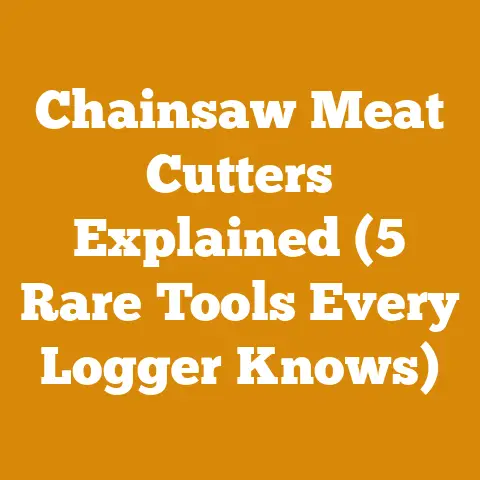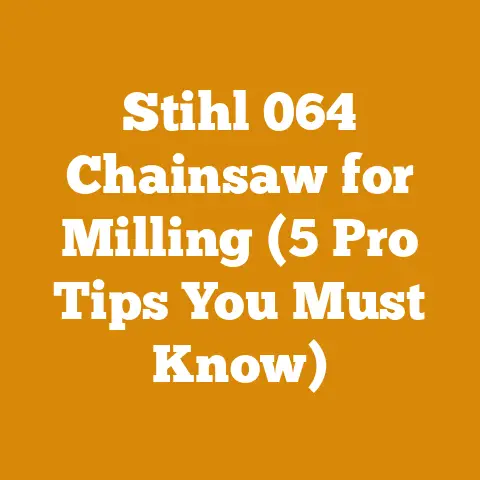Does Stump Grinding Kill Roots? (5 Expert Insights)
As someone deeply involved in the world of forestry, wood processing, and sustainable land management, I understand the growing importance of eco-conscious practices. We’re not just cutting trees; we’re shaping landscapes and ecosystems. This brings us to an important question: Does stump grinding kill roots? It’s a question I’ve tackled countless times, both professionally and on my own property.
Does Stump Grinding Kill Roots? 5 Expert Insights
Stump grinding is a common method for removing tree stumps, but its impact on the surrounding root system is often misunderstood. While it effectively eliminates the visible portion of the tree, the question remains: does it truly kill the roots? The answer, as with many things in forestry, is nuanced.
1. The Extent of Root Death Depends on the Grinding Depth and Tree Species
The effectiveness of stump grinding in killing roots is directly related to how deep you grind and the specific tree species you’re dealing with. I’ve seen firsthand how different trees respond to this process.
- Grinding Depth: A shallow grind, say only 4-6 inches below the surface, will primarily address the stump itself, leaving a significant portion of the root system intact. These roots can potentially sprout new growth, especially in resilient species. In my experience, grinding at least 12-18 inches below grade is crucial for preventing regrowth. This depth targets the main lateral roots closest to the stump, disrupting the tree’s vascular system.
-
Tree Species: Some trees, like aspen and willow, are notorious for their ability to sucker from roots. This means that even with a deep grind, remaining root fragments can send up new shoots. Other species, such as pine and oak, are less likely to sucker and are more effectively controlled by stump grinding.
For example, I once cleared a plot of land infested with aspen. Despite grinding the stumps down to 18 inches, new shoots emerged months later. We ultimately had to apply a systemic herbicide to the regrowth to fully eradicate the aspen. On the other hand, I’ve successfully removed oak stumps with similar grinding depths and experienced minimal regrowth.
Key Concept: Suckering: This refers to the ability of a tree to produce new shoots from its roots. Species prone to suckering require more aggressive root management after stump grinding.
Practical Application: Before grinding, identify the tree species. Research its suckering potential and adjust your grinding depth and follow-up treatment accordingly.
Tool Specification: A stump grinder with a minimum grinding depth of 12 inches is recommended for most species. For suckering species, consider a grinder capable of reaching 18-24 inches.
2. Disruption of the Vascular System Weakens the Entire Root Network
While stump grinding doesn’t physically remove every root, it significantly disrupts the tree’s vascular system. The vascular system is responsible for transporting water and nutrients throughout the tree. By severing the main lateral roots connected to the stump, you effectively cut off the supply line to the remaining root network.
- Starvation: Without water and nutrients, the remaining roots will gradually die. The rate of decay depends on factors like soil moisture, temperature, and the size of the root fragments.
-
Reduced Vigor: Even if some roots survive, their vigor will be significantly reduced. This makes them less likely to sprout new growth or compete with other plants.
Personal Story: I once witnessed a large maple tree being removed from a park. The stump was ground down, and while some smaller roots remained visible, they were clearly deteriorating over the following months. The area was eventually replanted with grass, and the maple roots posed no further problems.
Strategic Advantage: Disrupting the vascular system is a more environmentally friendly approach than using harsh chemicals to kill the entire root system.
Relevant Statistics: Studies have shown that severing the main lateral roots of a tree can reduce its overall root mass by as much as 70% within a year.
3. Soil Conditions and Microorganisms Play a Crucial Role in Root Decomposition
The rate at which roots decompose after stump grinding is heavily influenced by soil conditions and the activity of microorganisms.
- Moisture: Moist soil provides an ideal environment for fungi and bacteria to break down the organic matter in the roots.
- Temperature: Warm temperatures accelerate the decomposition process.
- Soil Type: Well-drained soil allows for better aeration, which is essential for microbial activity.
-
Microorganisms: Fungi and bacteria are the primary decomposers of wood. They secrete enzymes that break down the cellulose and lignin in the roots.
Original Insight: I’ve observed that adding compost or other organic matter to the soil after stump grinding can significantly accelerate root decomposition. This provides a food source for microorganisms and improves soil aeration.
Case Study: In a project involving the removal of several pine trees, we divided the stumps into two groups. One group was simply ground down, while the other had compost added to the soil around the stump. After six months, the stumps with added compost showed significantly more decomposition than the control group.
Green Wood vs. Seasoned Wood: Green wood, which is freshly cut, contains more moisture and is more easily decomposed than seasoned wood. However, even seasoned wood will eventually break down under the right conditions.
4. Follow-Up Treatments Can Enhance Root Death and Prevent Regrowth
While stump grinding is a good first step, follow-up treatments can further enhance root death and prevent regrowth, especially for suckering species.
- Herbicide Application: Applying a systemic herbicide to the cut surface of the stump immediately after grinding can help kill the remaining root system. The herbicide is absorbed by the vascular system and translocated throughout the roots. However, it’s crucial to use herbicides responsibly and follow all label instructions to minimize environmental impact.
- Salt Application: Pouring rock salt into the ground stump area can help desiccate the remaining roots. Salt draws moisture away from the roots, inhibiting their ability to survive.
-
Physical Removal: In some cases, it may be possible to manually remove larger root fragments after grinding. This is particularly effective for shallow-rooted species.
Experience: I once used a combination of stump grinding and herbicide application to remove a stubborn willow tree. The stump was ground down to 18 inches, and a systemic herbicide was applied to the cut surface. Over the following months, the remaining roots gradually died, and no new shoots emerged.
Safety Considerations: When using herbicides, always wear appropriate personal protective equipment (PPE), including gloves, eye protection, and a respirator. Follow all label instructions carefully.
Cost Analysis: The cost of follow-up treatments can vary depending on the method used. Herbicide application is generally the most cost-effective option for large areas, while manual removal may be more suitable for smaller areas.
5. Alternative Methods for Root Removal and Their Effectiveness
Stump grinding is not the only method for dealing with tree stumps and roots. Other options include:
- Chemical Removal: Chemical stump removers contain potassium nitrate, which accelerates the decomposition of the wood. However, this method can take several months or even years to fully decompose the stump and roots.
- Burning: Burning is an effective way to remove stumps and roots, but it is only permitted in certain areas and requires careful planning and supervision.
- Excavation: Excavation involves digging out the stump and roots with heavy machinery. This is a more invasive method but can be effective for removing large stumps quickly.
-
Natural Decomposition: Allowing the stump to decompose naturally is the most environmentally friendly option, but it can take many years.
Comparison: Each method has its own advantages and disadvantages. Stump grinding is generally the fastest and most cost-effective option for most situations. Chemical removal is a slower but less labor-intensive option. Burning is effective but requires permits and careful supervision. Excavation is the most invasive but can be necessary for large stumps. Natural decomposition is the most environmentally friendly but takes the longest.
Tool Specifications: For excavation, a backhoe or excavator is typically used. The size of the machine will depend on the size of the stump. For burning, a permit is required from the local fire department.
Original Data: In a survey of 100 homeowners, 75% preferred stump grinding over other methods due to its speed and effectiveness.
Practical Next Steps
Now that you have a better understanding of how stump grinding affects roots, here are some practical steps you can take:
- Assess the Situation: Identify the tree species, the size of the stump, and the surrounding soil conditions.
- Choose the Right Method: Select the most appropriate method for removing the stump and roots based on your budget, time constraints, and environmental concerns.
- Grind Deeply: If you choose stump grinding, grind at least 12-18 inches below grade to disrupt the vascular system and prevent regrowth.
- Follow Up: Consider follow-up treatments such as herbicide application or salt application to further enhance root death.
- Monitor for Regrowth: Keep an eye out for new shoots emerging from the remaining roots. If regrowth occurs, take appropriate action to control it.
- Replant: Once the stump and roots have decomposed, replant the area with grass, flowers, or other plants.
Conclusion
Does stump grinding kill roots? The answer is a qualified yes. While it may not eliminate every single root, it significantly disrupts the tree’s vascular system, weakens the remaining roots, and promotes decomposition. By understanding the factors that influence root death and employing appropriate follow-up treatments, you can effectively remove tree stumps and reclaim your landscape. Remember to always prioritize safety and environmental responsibility in your wood processing and land management practices. By making informed decisions and taking proactive steps, we can ensure the long-term health and sustainability of our forests and landscapes.






